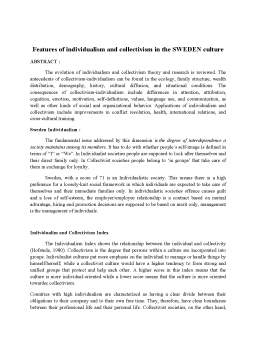Extras din referat
ABSTRACT :
The evolution of individualism and collectivism theory and research is reviewed. The antecedents of collectivism-individualism can be found in the ecology, family structure, wealth distribution, demography, history, cultural diffusion, and situational conditions. The consequences of collectivism-individualism include differences in attention, attribution, cognition, emotion, motivation, self-definitions, values, language use, and communication, as well as other kinds of social and organizational behavior. Applications of individualism and collectivism include improvements in conflict resolution, health, international relations, and cross-cultural training.
Sweden Individualism :
The fundamental issue addressed by this dimension is the degree of interdependence a society maintains among its members. It has to do with whether people´s self-image is defined in terms of “I” or “We”. In Individualist societies people are supposed to look after themselves and their direct family only. In Collectivist societies people belong to ‘in groups’ that take care of them in exchange for loyalty.
Sweden, with a score of 71 is an Individualistic society. This means there is a high preference for a loosely-knit social framework in which individuals are expected to take care of themselves and their immediate families only. In individualistic societies offence causes guilt and a loss of self-esteem, the employer/employee relationship is a contract based on mutual advantage, hiring and promotion decisions are supposed to be based on merit only, management is the management of individuals.
Individualim and Collectivism Index
The Individualism Index shows the relationship between the individual and collectivity (Hofstede, 1980). Collectivism is the degree that persons within a culture are incorporated into groups. Individualist cultures put more emphasis on the individual to manage or handle things by himself/herself; while a collectivist culture would have a higher tendency to form strong and unified groups that protect and help each other. A higher score in this index means that the culture is more individual-oriented while a lower score means that the culture is more oriented towardsc collectivism.
Countries with high individualism are characterized as having a clear divide between their obligations to their company and to their own free time. They, therefore, have clear boundaries between their professional life and their personal life. Collectivist societies, on the other hand, consider obligations to groups such as a company to be of more importance and there is a feeling of time not belonging to oneself but a commodity that is shared by a group, therefore having less clear boundaries between professional and personal time. Collectivist societies, due to their stronger tendency towards group orientation, will also be relationship-oriented in their way of doing business and as a result, they are less inclined to do business outside of a relationship. And, before doing business, they will first attempt to create relationship if none is existent from the start. Collectivist societies attempt to avoid conflict and maintain harmony by the use of indirect speech in order not to offend somebody; this is also known as high context communication that puts more responsibility on the receiver to interpret a message clearly. Highly individualistic countries use a low context way of communication, which means that they tend to communicate their requests and demands in a more direct way.
Some info:
Individualism is the one side versus its opposite, collectivism, that is the degree to wich individuals are integrated into group. On the individualist side we find societies in wich the ties between individuals are loose: everyone is expected to look after him/herself and his/her immediate family. On the collectivist side, we find societies in wich people from birth onwards are integrated intro strong, cohesive in-groups, often extended families (with uncles, aunts and grandparents) wich continue protecting them in exchange for unquestioning loyality.
Preview document
Conținut arhivă zip
- Features of individualism and collectivism in the Sweden culture.docx






